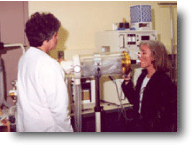 |
Scientist and worker using a lung capacity
measuring machine. |
Although the primary method of controlling occupational respiratory disease is the prevention of adverse exposures (e.g., through hazard exposure limits, dust suppression, or personal protective equipment), some individuals may continue to be affected. This can occur when workers experience excessive exposures despite control measures, or when workers are unusually susceptible to the hazard. It is critical to detect early signs of disease and take action to reduce further exposure in these individuals in order to prevent significant medical conditions. This is why worker medical monitoring and screening is necessary. Worker monitoring includes a variety of medical tests and procedures, including radiography, spirometry, questionnaires, and biomarkers. Some of these techniques have been employed for years in various industrial groups, while new monitoring techniques continue to be developed. In many cases, optimum methods have yet to be developed for the application and interpretation of existing medical monitoring techniques. (Slide Show: Lung sections from victims of pneumoconiosis  PDF only 4,550 KB (18 pages)) PDF only 4,550 KB (18 pages))
|
.gif) |
Index
- Radiographic monitoring for the pneumoconioses, especially coal workers' pneumoconiosis (CWP), is a widely accepted practice. In the United States, NIOSH operates the Coal Workers' Health [or X-ray] Surveillance Program, which is designed to detect early signs of CWP and inform the miner. Miners with CWP may be eligible to transfer to a job with reduced dust exposures, without a reduction in pay grade. NIOSH also operates the B-reader program, designed to test physicians for profiency in reading chest x-rays for the pneumoconioses according to the International Labor Office (ILO) criteria.
|
- Spirometric testing is frequently utilized in the United States to monitor workers at risk for chronic obstructive pulmonary disease and asthma. NIOSH is evaluating methods for the optimal application and interpretation of spirometry in the workplace. As one step in assuring the quality of pulmonary function testing done in the workplace, the NIOSH-Approved Spirometry Training Program currently reviews and certifies training classes for spirometry technicians.
|
|
|
|
|
NIOSH Products Related to Worker Medical Monitoring |
| |
NIOSH B Reader Certification Program
NIOSH B Reader certification is granted to physicians who demonstrate proficiency in the classification of chest x-rays for the pneumoconioses using the International Labour Office (ILO) Classification System. |
| |
NORA Health Services Research
Occupational Health Services Research, one of the 21 NORA priority areas, focuses on the organization, financing, and management of occupational health care services to assess their impact on the occupational health care delivery, quality, cost, access, and outcomes. |
| |
NIOSH
Spirometry Training Guide
DHHS (NIOSH) Publication No. 2004-154c
This
guide is used to teach spirometry technicians how to collect accurate spirometry
data and alerts technicians how to identify and avoid potential sources of error
during testing. Occupational health professionals will find the guide useful;
however the guide does not replace the practical aspects of a formal training
program. |
| |
| Pneumoconiosis, a NIOSH workplace safety and health topic. |
| |
Other Resources Related to Worker Medical Monitoring |
| |
| The links to external web sites included below are provided for informational purposes only. Citation should not be taken as endorsement by NIOSH of the web site content nor of the sponsoring organization. |
| |
Medical Screening/Surveillance
External link: http://www.osha.gov/SLTC/medicalsurveillance/index.html
An Occupational Safety and Health Administration (OSHA) safety and health topic. |
| |
Spirometry in the Occupational Setting
External link: http://www.acoem.org/guidelines/article.asp?ID=36
In 2000, the American College of Occupational and Environmental Medicine (ACOEM) published an evidence-based position paper with guidelines for using spirometry in the occupational setting. Health and safety officers may find these guidelines useful when using spirometry as part of their medical monitoring and screening programs. |
| |
Standardization of Spirometry, 1994 Update
External link: http://www.thoracic.org/adobe/statements/spirometry1-30.pdf
 PDFonly 162 KB (30 pages) PDFonly 162 KB (30 pages)
The official statement of the American Thoracic Society (ATS) on the standardization of Spirometry |
| |
|

